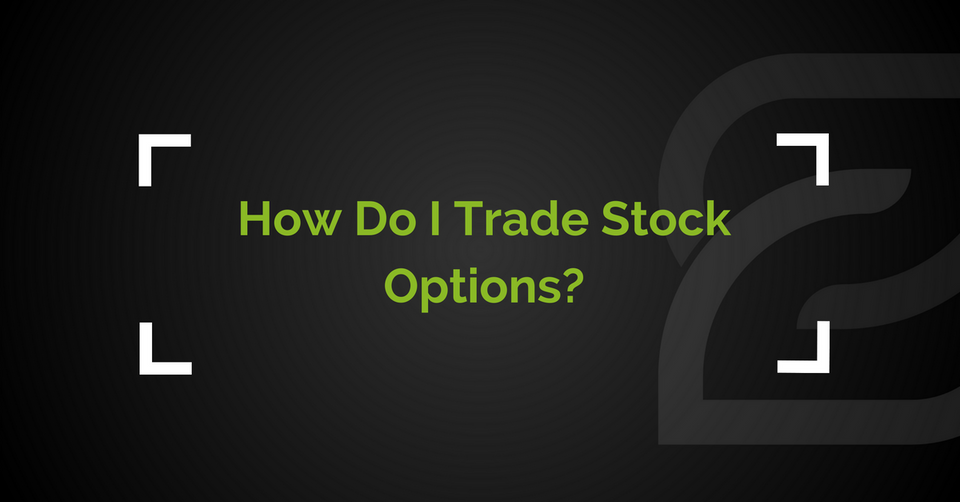How Do I Trade Stock Options?

WHY: When you believe the stock will rise significantly over time and you want to leverage your returns, or you want to minimize invested capital at risk — you buy a CALL option contract.
Investors or traders often buy call options rather than stocks, when they want to leverage and potentially enhance their returns significantly whilst at the same time cap the loss to what is being invested i.e. the maximum you can lose, is the option price (premium) you paid for each contract — which is usually smaller than what you would have paid for the outright purchase of the stock. That’s because each contract represents 100 shares that an investor or trader can control and benefit from.
For example, imagine a stock that you know well, that has been hit hard recently and now trades at $30. You have strong reason to believe that is was oversold, and that it will rebound and trade back at $50 in the coming months or year.
The market offers $35 call option contract that expires in nine months for a price (premium) of $1.5 per share. Since each contract represents 100 shares — that’s $150 per contract. If you take 10 contracts, that’s equivalent to owning 1,000 shares — the premium (price) would be $1,500 (plus your brokerage commissions). This contract if purchased, would give you the owner of the contract, the right to buy 1,000 shares of the stock at $35 any time before expiration.
If the price of the share, rose to $40 in a few months — your option contract will increase in value too, perhaps double to $3 or more per share. That means you could make 100% in just a few months, as compared to 16% if you simply bought the stock.
Catch 22: What’s the catch? There isn’t — but there’s a possible downside. Imagine the stock price continued its decline (for whatever reason) for a few months and your option contract would decrease in value, perhaps to $0.25 per share. After nine months, the price is now at $20, your option contract would expire worthless. You’ve heard the phrase 90% of all options expire worthless, so what are you chances? (What! You had no Plan B? Time to discover The 7Ps of Trading).
Because this is a just a guide, and there’s a limitation to what can be explained — you’ll need to figure out how to identify fundamentally strong companies (in a span of a few minutes) that better your chances of outperforming the market and give you the edge you need to make money.
Buying Puts
WHY: When you believe the stock will fall in price, you want to short the stock or you want to hedge a current long holding position — you buy a PUT option contract.
Buying PUTS is useful when you believe the stock or sector is overpriced or going to face trouble.
PUT options will continue to gain value, if the stock goes down. However, there’s a limit… once the stock goes to zero.
Catch 22: The maximum you can lose, is the option price (premium) you paid for each contract. But there’s technically a maximum you can gain here, because the price of the underlying stock cannot go below zero. Also, unlike in traditional short selling (which is selling borrowed stock at a high price and buying it back at a low price) where the losses can be unlimited (if the price of the stock continues to rise), with buying put options — your loss is limited to the option price (premium) you paid.
When you combine buying PUT option contracts with a stock that you already own — then, you’re basically protecting yourself (and your portfolio), this is known as buying ‘protective puts’ or commonly called ‘hedging’ and helps with preserving your capital, rather for capital gains. So when the stock price decreases, the value of the contract will increase, smoothing out your returns.
For example, you already own shares at $50 per share, assuming you had 100 shares — that’s $5,000. Now the price is $70, so that’s $2,000 worth of unrealized gain. If you sold, you would realize a profit of $2,000 — but that also means if the price went up further — you could not benefit. In such a situation, you could buy a put option say at $80 for $2 per contract. That means you’d spend an additional $200 to cover your position. Now, if the markets go up higher, and your contract was exercised — You’d receive your $80 x 100 = $8,000, minus the cost of the option you purchased i.e. $200.
But if the market went down further, and the share price went to $40. And your option was exercised, you wouldn’t have to take the loss of $1,000 by selling at a lower market price.
Buying LEAPS (Long Term Options)
Why: They are less expensive than stocks and not as volatile as short term stock options and as a result, not as sensitive to time decay, until you a few months are left for expiry. Whilst they provide leverage, it’s not as much as short term options, but sufficient for stock traders.
LEAPS is an acronym for Long-term Equity AnticiPation Securities. A mouthful, maybe. These were launched in 1990s, as options that had an expiry as far out as three years. You could say, it was the best of both worlds — for stock traders and option traders.
Next, we’ll move from buying options, to selling options to others. When you sell an option, you don’t pay a premium, instead, as the contract writer (seller), you get paid a premium. And the best part, is that it’s an immediate payment and you get to keep it!

Member discussion